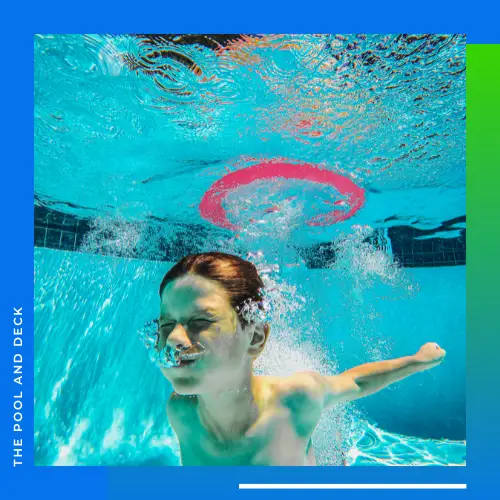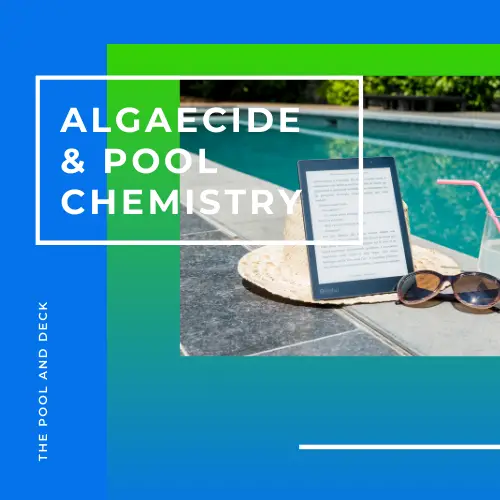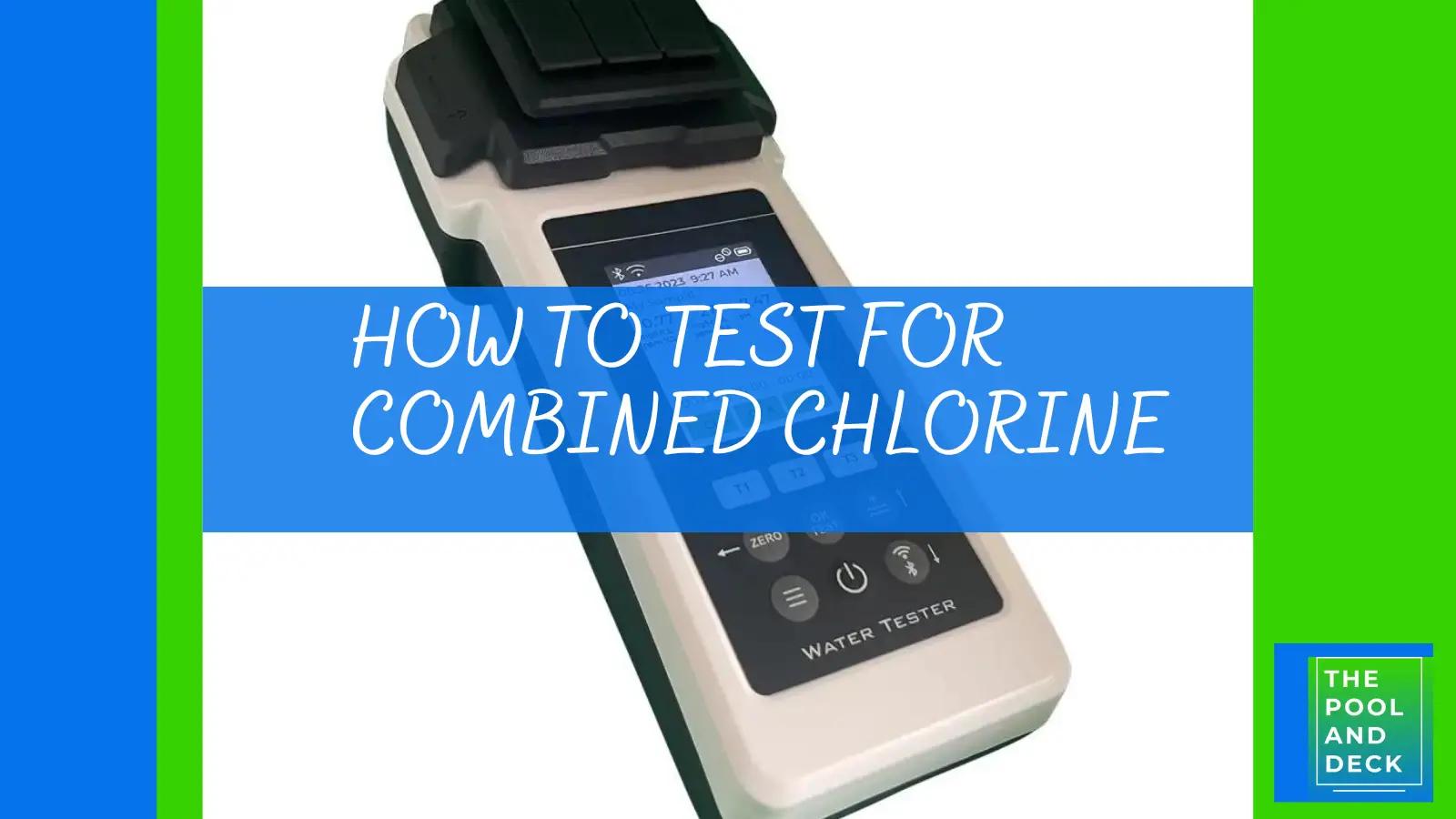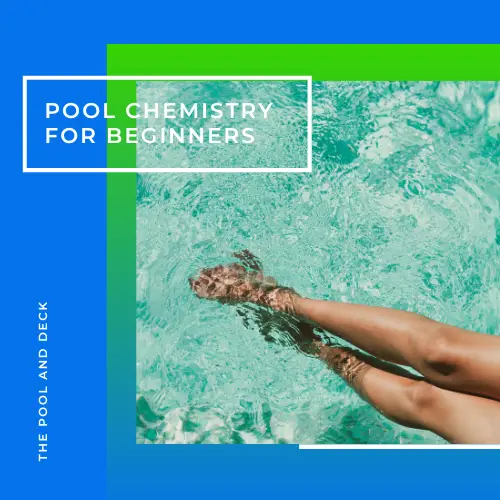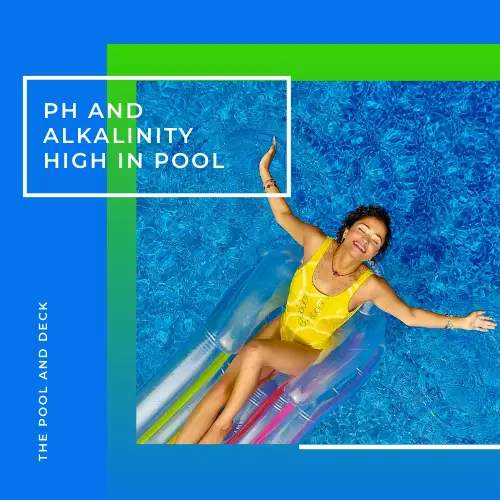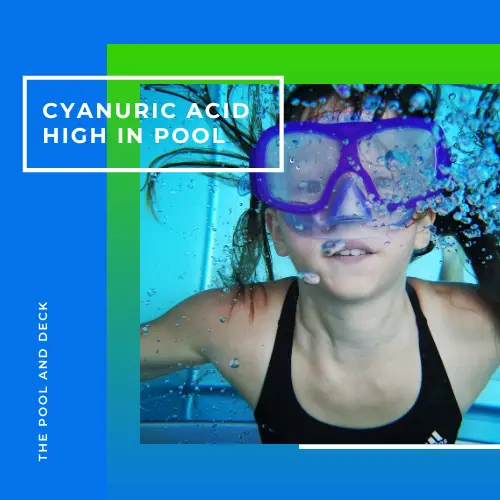Combined Chlorine: Overview by a Pool Expert
As an Amazon Associate, I earn from qualifying purchases.
Even as a new pool owner, I am sure you understand the importance of adequate chlorine levels for pool sanitation. But have you encountered the term combined chlorine?
A high level of combined chlorine is the culprit behind that strong chlorine smell, red eyes, and itchy skin after a swim.
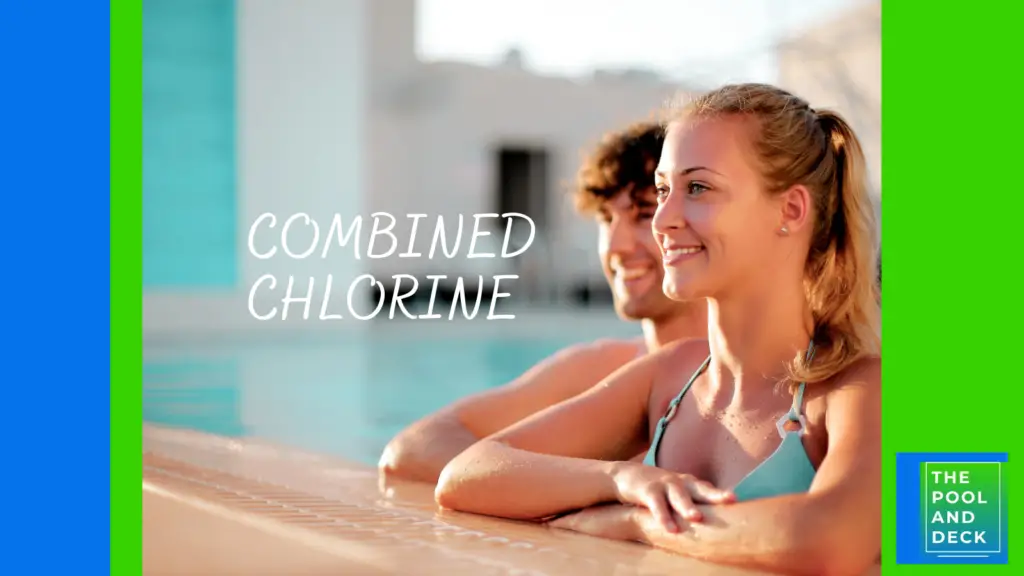
KEY TAKEAWAYS
- Combined chlorine is formed when free chlorine reacts with contaminants in pool water.
- High levels of combined chlorine can irritate skin and eyes and create an unpleasant chlorine smell.
- Free chlorine, not combined chlorine, is the active sanitizer in pool water.
- Swimmers’ bodily fluids are a major source of organic nitrogen that contributes to combined chlorine formation.
- Breakpoint chlorination (adding a high dose of chlorine) is used to break down combined chlorine.
- Using Pool covers and encouraging swimmers to shower before entering the pool are good preventative measures.
Table of Contents
What is Combined Chlorine?
Combined chlorine, also known as chloramines, is a byproduct of chlorine interacting with contaminants like ammonia in pool water.
Unlike free chlorine, which actively eliminates bacteria and microorganisms, combined chlorine is less effective in sanitizing the water.
High combined chlorine levels can result in unpleasant odors, skin irritation, and potential health risks for swimmers.
Therefore, monitoring and managing combined chlorine levels is crucial for maintaining a safe and healthy swimming environment.
For more information, read What is Combined Chlorine? Beginner’s Quick Guide
What is Free Chlorine?
When chlorine is added to the pool it reacts with water to form hypochlorous acid (HOCl) and hypochlorite ions (OCl⁻), which together are referred to as free chlorine. This is represented by the chemical equations below:
Formation of Hypochlorous Acid (HOCl):
Cl2+H2O⇌HOCl+HClCl2+H2O⇌HOCl+HCl
Dissociation of Hypochlorous Acid (HOCl):
HOCl⇌H++OCl−HOCl⇌H++OCl−
The equilibrium is influenced by factors such as pH. The chemical equations for these reactions are as follows:
Together, these reactions can be represented as a net equation:
Cl2+H2O⇌H++OCl−+HClCl2+H2O⇌H++OCl−+HCl
This equation represents the dynamic equilibrium between molecular chlorine (Cl₂), hypochlorous acid (HOCl), hypochlorite ions (OCl⁻), and hydrogen ions (H⁺) in water.
Formation of free chlorine in pool water is the first and the most important reaction as it is crucial for disinfection. Free chlorine sanitzes and eliminates algae, bacteria and other pathogens.
Formation of Combined Chlorine
Combined chlorine is formed when free chlorine in pool water reacts with nitrogen-containing compounds, such as ammonia and organic matter introduced by swimmers to form Chloramines.
Free Chlorine can combine with any ammonia (a component of body fluids) to form chloramines. Ammonia goes through the following stages.
Ammonia (NH3) ==> Monochloramine (NH2Cl) ==> Dichoramaine (NHCl2) ==> Trichloramine (NCl3)
As chemical reactions the process can be written as:
Stage 1: Monochloramine Formation
2NH3+2HOCl→2NH2Cl+2H2O
In this equation, NH3 represents ammonia, HOCl represents hypochlorous acid, NH2Cl represents monochloramine, and H2O represents water.
Stage 2: Dichloramine Formation
2NH2Cl+2HOCl→2NHCl2+2H2O
In this equation, NH2Cl represents monochloramine, HOCl represents hypochlorous acid, NHCl2 represents dichloramine, and H2O represents water.
Stage 3: Trichloramine Formation
2NHCl2+2HOCl→2NCl3+2H2O
In this equation, NHCl2 represents dichloramine, HOCl represents hypochlorous acid, NCl3 represents trichloramine, and H2O represents water.
Understanding Nitrogen Sources in Pool Water
As we have seen Combined Chlorine is formed when Chlorine reacts with Nitrogen compounds. But how does Nitrogen enter your pool? Well, Nitrogen enters the pool water, both in organic and inorganic forms.
Organic Nitrogen
The main source of organic nitogen is swimmers’ bodily fluids. Urea, primarily found in sweat and urine, is a major source of organic nitrogen.
Urea breaks down into ammonia or ammonia-rich complex compounds. Free chlorine reacts with ammonia to form chloramines which is essentially combined chlorine.
Inorganic Nitrogen
Certain algaecides and other pool chemicals may contain inorganic nitrogen compounds like ammonia or ammonium.
Inorganic nitrogen-based compounds may also enter whenever you top up the depletion of pool water caused by backwashing or evaporation.
Rainwater can be another source of nitrogenous compounds, especially if you live close to chemical industries, where the air is often polluted with chemicals.
| Feature | Organic Nitrogen | Inorganic Nitrogen |
|---|---|---|
| Origin | Swimmers’ bodily fluids, organic matter | Pool chemicals, algaecides, rainwater |
| Form | Urea, ammonia, organic chloramines | Ammonia, ammonium, nitrates, nitrites, inorganic chloramines |
| Impact on disinfection | Contributes to combined chlorine formation, reducing disinfection effectiveness | Contributes to combined chlorine formation, reducing disinfection effectiveness |
Controlling Nitrogen Sources
Quite obviously, if you can ensure that the entry of nitrogen based compounds, organic or inorganic, are restricted then you have a better chance of keeping Combined Chlorine levels in your pool in check.
Maintaining strict pool etiquette for swimmers is the key to reducing the entry of nitrogen-based organic compounds.
Swimmers must shower before entering the pool. Swimsuits must be washed after a day of swimming. And no peeing in the pool!
To reduce the entry of inorganic nitrogen-based compounds in to your pool start by having your water source tested for contaminants. You may need to install a water treatment system in case nitrogen, calcium or other metals are high.
It also helps to ensure that you minimize the use of pool chemicals that are rich in nitrogen compounds. Try and find alternatives!
Do you have a garden next to the pool where you use fertilizers? Make sure the wind does not carry some of the fertilizers in to the pool. Fertilizers are typically, rich in Nitrogen.
Installing a glass pool fence and the use of pool covers are ways to prevent nitrogen-based chemicals from getting into your pool.
Impact of Combined Chlorine on Pool Water Chemistry
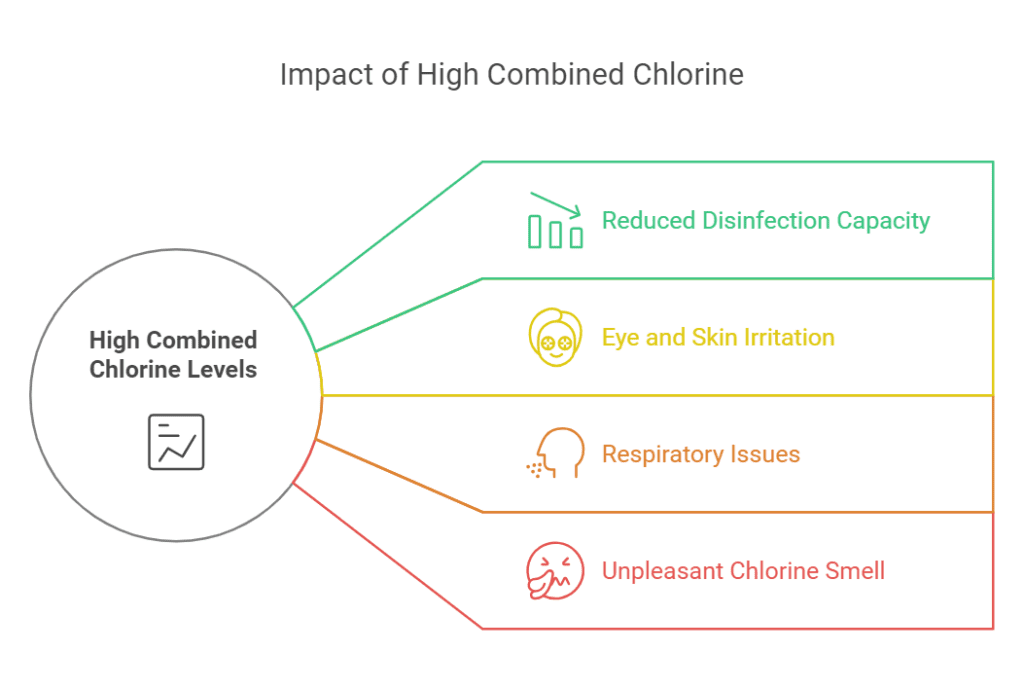
High combined chlorine levels result in an unpleasant and unsafe swimming environment. Specifically high levels of combined chlorine have the following adverse effects:
- Reduced Disinfection Capacity: Combined chlorine is less effective at sanitizing the pool than free chlorine. As a result, microbes such as algae, bacteria, and other pathogens can proliferate in the pool.
- Eye and Skin Irritation: Prolonged exposure to high combined chlorine levels can cause eye and skin irritation, leading to discomfort and poor swim experience.
- Respiratory Issues and Health Risks: Prolonged exposure to elevated combined chlorine levels can lead to respiratory issues, such as asthma and bronchitis.
- Unpleasant Chlorine Smell: Elevated combined chlorine levels usually produce a strong chlorine odor, making the pool unpleasant for swimmers.
For more information, read Pool Chemistry for Beginners: With 5 Super Helpful Cheat Sheets!
Free Chlorine vs Combined Chlorine
Free chlorine is the active form of chlorine that effectively sanitizes pool water by eliminating bacteria and microorganisms.
In contrast, combined chlorine is the byproduct of free chlorine reacting with contaminants, such as ammonia and nitrogen compounds, in the pool water. Combined chlorine is less effective at disinfection than free chlorine.
However, at any given point in time, both Free Chlorine and Combined Chlorine will co-exist in the pool water.
As a pool owner, your objective must be to keep Free Chlorine within the recommended levels (typically 1-4 ppm) and Combined Chlorine below 1 ppm.
For more information, read Free Chlorine vs Combined Chlorine Guide
Free Chlorine, Combined Chlorine & Total Chlorine
Actually, the relationship between Free Chlorine (FC), Combined Chlorine (CC) and Total Chlorine (TC) is rather simple. Total Chlorine (TC) is the sum of Free Chlorine (FC) and Combined Chlorine (CC).
Total Chlorine (TC) = Free Chlorine (FC) + Combined Chlorine (CC)
Most test methods are able to detect Total Chlorine (TC) and Free Chlorine (FC) levels in pool water. Combined Chlorine (CC) level is therefore determined by subtracting Free Chlorine (FC) from Total Chlorine (TC).
Combined Chlorine (CC) = Total Chlorine (TC) – Free Chlorine (FC)
Maintaining Higher Free Chlorine Levels
In pool water, free chlorine is the primary disinfectant, while combined chlorine is less effective at eliminating contaminants.
It is, therefore, important to maintain a higher level of free chlorine compared to combined chlorine to ensure effective sanitation and keep the formation of combined chlorine in check.
This proactive approach helps safeguard water quality and create a safer, more enjoyable swimming environment for all.
How to Test for Combined Chlorine in Pool Water
The available test methods will, typically, give you Total Chlorine and Free Chlorine readings. Combined Chlorine is easily determined by subtracting Free Chlorine from Total Chlorine.
The 3 most commonly test methods used for testing pool water quality in residential pools are:
- Test Strips
- Chemical Test Kits
- Electronic Testers
For more information, read How to Test for Combined Chlorine: 3 Best Methods
Recommended Chemical Test Kit
Taylor K-2005 Complete DPD 9-in-1 Test Kit
Tests for free & total chlorine, bromine, pH, total alkalinity, total hardness, and cyanuric acid (CYA) levels.
For example, a simple test kit using DPD (N, N-diethyl-p-phenylenediamine) reagent is available at pool supply stores. Here’s how to test:
- Collect a pool water sample.
- Mix the sample with DPD reagent according to the test kit instructions.
- Observe the color change in the sample.
- Compare the color change to the provided color chart to determine the combined chlorine concentration.
Regular testing lets you monitor Combined Chlorine levels and take corrective measures to maintain optimal water quality and a safe swimming environment.
How To Lower Combined Chlorine Level in a Pool
When combined chlorine levels are too high in your pool, you need effective solutions to bring them back under control.
Chemical Solutions
- Superchlorination/Shocking:
- What It Is: Also called breakpoint chlorination, this involves adding a high dose of chlorine to eliminate combined chlorine by breaking apart chloramines.
- How It Works: When chlorine levels reach 10 times the amount of combined chlorine, the chloramines are oxidized and destroyed.
- Steps to Perform Safely:
- Calculate how much chlorine your pool needs.
- Add the chlorine in the evening to avoid sunlight interference.
- Circulate the water for 8–12 hours before retesting.
- Non-Chlorine Shock (Potassium Monopersulfate):
- Benefits: A chlorine-free alternative that oxidizes contaminants without raising chlorine levels.
- Limitations: It doesn’t kill bacteria, so maintaining free chlorine is still essential.
- Enzymes for Chloramine Reduction:
- How They Help: Specialized enzyme products (like CV-600) break down organic contaminants, preventing combined chlorine formation and supporting chlorine efficiency.
Recommended: Cyanuric Acid Free Shock (Cal Hypo)
HTH 52037 Pool Care Shock Advanced
A fast-dissolving, convenient 4-in-1 Cal Hypo formula that kills bacteria & algae, reduces chlorine odor & irritation, and quickly restores crystal clarity.
Breakpoint Chlorination
Breakpoint chlorination is the quantity of chlorine that is just enough to meet the chlorine demand of the contaminants. This level of chlorination will completely neutralize all the combined chlorine (mostly chloramines) in the pool.
Below is what the breakpoint chlorination curve looks like.

A rule of thumb is that the amount of chlorine to be added should be 10X the amount of Combined Chlorine in the pool. Any further addition of chlorine will only increase the free chlorine level in your pool and will not be consumed.
For more information, read Breakpoint Chlorination: Most Effective Method
Physical and Advanced Solutions
- UV Systems:
- Ultraviolet light disrupts and breaks down chloramines, effectively reducing combined chlorine levels.
- Ideal for indoor pools with limited ventilation.
- Ozone Generators:
- Ozone is a powerful oxidizer that removes contaminants, reducing the workload on chlorine.
- It works well alongside standard chlorination systems for a comprehensive solution.
- Advanced Oxidation Processes (AOP):
- These systems combine UV, ozone, and other oxidizers to create highly reactive molecules that destroy chloramines and other contaminants.
- Hyper-Dissolved Oxygen (HDO): Another emerging technology that boosts water clarity and sanitation effectiveness.
Preventive Measures
- Pool Covers:
- Using covers reduces debris and minimizes the organic contaminants that lead to chloramine formation.
- Educating Pool Users:
- Encourage swimmers to shower before entering the pool. Clean swimmers mean fewer contaminants in the water.
Pool Hygiene:
Maintaining proper pool hygiene, including regular cleaning, filtering, and maintaining proper pH and stabilizer levels, is a preventive strategy that minimizes the introduction of contaminants that contribute to combined chlorine formation.
By combining these approaches, you can effectively lower combined chlorine levels and prevent future buildup.
For more information, read How To Lower Combined Chlorine Levels? (The Best Fix!)
Advanced Pool Chemistry Concepts
For long-term success in managing combined chlorine, understanding some advanced pool chemistry concepts is helpful.
Chlorine Lock vs. Chlorine Demand
- Chlorine Lock:
- What It Is: Occurs when excessive stabilizer (Cyanuric Acid or CYA) binds with chlorine, making it less effective.
- How It Relates to Combined Chlorine: A chlorine lock can lead to an increase in combined chlorine because there isn’t enough free chlorine available to oxidize contaminants.
- Solution: Partially drain and refill the pool to reduce CYA levels, then shock the pool to break the chlorine lock.
- Chlorine Demand:
- What It Is: The inability to maintain chlorine levels because organic and inorganic contaminants are overwhelming the system.
- How It Relates to Combined Chlorine: When chlorine demand is high, free chlorine is quickly consumed, leading to chloramine formation.
- Solution: Perform a double shock or use an oxidizing agent to eliminate the excess demand.
Optimizing Cyanuric Acid (CYA) Levels
- Why It’s Important: CYA acts as a sunscreen for chlorine, protecting it from UV breakdown. However, too much CYA can reduce chlorine’s effectiveness.
- Ideal Range: Maintain CYA levels between 30–50 PPM for outdoor pools. For indoor pools, CYA should be kept minimal or avoided entirely.
- How It Helps: Balanced CYA ensures that free chlorine remains active and minimizes the formation of combined chlorine.
Thank you very much for reading the post. I do hope you found it informative and helpful.


